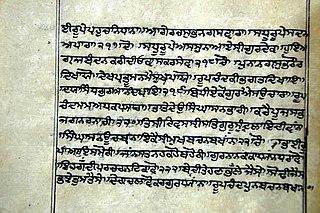
Barot is a caste native to Gujarat and Rajasthan. They traditionally worked as historians, genealogists and mythographers. [1]

Barot is a caste native to Gujarat and Rajasthan. They traditionally worked as historians, genealogists and mythographers. [1]
The caste is also known as "Vahivancha Barots". The word Vahivancha (IAST: "Vahīvancā) literally means "one who reads a vahi" (vahi means a book of genealogy, a ledger or a book in general). The Vahivanchas traditionally maintained genealogies, told stories and recited bardic poetry. The term "Barot" was originally used as an honorific title for both Vahivanchas and Bhat, and was gradually adopted as a caste appellation by the Vahivanchas. [1]
According to one theory, the caste of Vahivancha Barots developed from the Bhats. Widespread tradition states that the Vahivanchas came to Gujarat from Rajputana during the Solanki period (942-1245 CE). The oldest extant Vahivancha book dates back to 1740 CE, written in Old Gujarati language. [1] They are said to be of Brahmin and Kshatriya origin. [2]
At present, the traditional occupation of Barots or Bhatts is on the verge of extinction as the new generation of the casts/communities for whom they worked as Barots, no longer patronise them. Further, the young generation of Barots, also have got involved in other occupation and businesses and higher studies. [2]

Genealogy is the study of families, family history, and the tracing of their lineages. Genealogists use oral interviews, historical records, genetic analysis, and other records to obtain information about a family and to demonstrate kinship and pedigrees of its members. The results are often displayed in charts or written as narratives. The field of family history is broader than genealogy, and covers not just lineage but also family and community history and biography.
Rajput, also called Thakur, is a large multi-component cluster of castes, kin bodies, and local groups, sharing social status and ideology of genealogical descent originating from the Indian subcontinent. The term Rajput covers various patrilineal clans historically associated with warriorhood: several clans claim Rajput status, although not all claims are universally accepted. According to modern scholars, almost all Rajput clans originated from peasant or pastoral communities.
Bhat is a surname in the Indian subcontinent. Bhat and Bhatt are shortened renditions of Brahmbhatt or Bhatta.

Folk music of Haryana has two main forms: classical folk music of Haryana and desi folk music of Haryana. They take the form of ballads and pangs of parting of lovers, valor and bravery, harvest and happiness.

Patidar, formerly known as Kanbi, is an Indian land-owning and peasant caste and community native to Gujarat. The community comprises at multiple subcastes, most prominently the Levas and Kadvas. They form one of the dominant castes in Gujarat. The title of Patidar originally conferred to the land owning aristocratic class of Gujarati Kanbis; however, it was later applied en masse to the entirety of the Kanbi population who lay claim to a land owning identity, partly as a result of land reforms during the British Raj.

Jadeja is a Rajput clan that inhabits the Indian state of Gujarat and the Tharparkar district of Sindh, Pakistan. They originated from Sammas of Sindh, a pastoral group, and laid a claim on the Rajput identity after marriages with Sodha Rajput women by adopting a process called Rajputisation.
The Gujarati people, or Gujaratis, are an Indo-Aryan ethnolinguistic group who reside in or can trace their ancestry or heritage to a region of the Indian subcontinent primarily centered in the present-day western Indian state of Gujarat. They primarily speak Gujarati, an Indo-Aryan language. While Gujaratis mainly inhabit Gujarat, they have a diaspora worldwide. Gujaratis in India and the diaspora are prominent entrepreneurs and industrialists and maintain high social capital. Many notable independence activists were Gujarati, including Mahatma Gandhi and Vallabhbhai Patel.

Charan is a caste in South Asia natively residing in the Rajasthan and Gujarat states of India, as well as the Sindh and Balochistan provinces of Pakistan. Historically, Charans have been engaged in diverse occupations like bards, poets, historians, pastoralists, agriculturalists and also administrators, jagirdars and warriors and some even as traders.
Genealogy registers of families, maintained by Brahmin Pandits known locally as ‘Pandas’, who work as professional genealogists, at Haridwar, have been a subject of study for many years. In several cases, these voluminous records known as Vahis (Bahi), have also been used in settling legal cases regarding inheritance or property disputes, as these records are considered sacrosanct both by the pilgrims and the Pandas themselves, and many of these records trace family history, for more than twenty prior generations, stretching across many centuries.

The Bhatra Sikhs are a sub-group within the Sikhs who originated from the bards of the time of Guru Nanak.
The Mirasi are a community found in North India and Pakistan. They are folklore tellers and traditional singers and dancers of a number of communities. The word "mirasi" is derived from the Arabic word (ميراث) mīrās, which means inheritance or sometimes heritage. In the strict grammatical sense of the term, they are considered to be propagators of the cultural and social heritage.

Bhat Vahis were scrolls or records maintained by Bhatts also known as Bhatra. The majority of Bhat Sikhs originate from Punjab and were amongst the first followers of Guru Nanak. Bhat tradition and Sikh text states their ancestors came from Punjab, where the Raja Shivnabh and his kingdom became the original 16th century followers of Guru Nanak, the founder of Sikhism. The Raja's grandson Prince Baba Changa earned the title ‘Bhat Rai’ – the ‘Raja of Poets, and then settled himself and his followers all over India as missionaries to spread the word of Guru Nanak, where many northern Indians became Bhat Sikhs. The majority were from the northern Brahmin caste ,(Bhat ) as the Prince Baba Changa shared the Brahmin heritage. The sangat also had many members from different areas of the Sikh caste spectrum, such as the Hindu Rajputs and Hindu Jats who joined due to Bhat Sikh missionary efforts. The Bhats also contributed 123 compositions in the Sri Guru Granth Sahib (pp.1389–1409), known as the "Bhata de Savaiyye". There hereditary occupations consisted of bards, poets, missionaries, astrologists, genealogists, salesmen.
The Bharbhunja are an occupational caste found in North India and Maharashtra. They are also known as Kalenra in Maharashtra. A small number are also found in the Terai region of Nepal.
The Kela are a Hindu community found in the states of Gujarat and Rajasthan in India. They are also known as Dhat Maheshwari.
Mahyavanshi are Rajput Caste in india and dominant caste.

The Koli is an Indian caste found in Rajasthan, Himachal Pradesh, Gujarat, Maharashtra, Uttar Pradesh, Haryana, Karnataka, Odisha and Jammu and Kashmir states in India. Koli is an agriculturist caste of Gujarat but in coastal areas they also work as fishermen along with agriculture. In the beginning of 20th century, the Koli caste was recognised as a denotified tribe under Criminal Tribes Act by the Indian Government because of their anti-social activities during World War I.
Modern historians agree that Rajputs consisted of a mix of various different social groups and different varnas. Rajputisation explains the process by which such diverse communities coalesced into the Rajput community.

Bhāt is a "generic term" used to refer to a bard in India. The majority of Bhats hail from Rajasthan and worked as genealogists for their patrons, however, they are viewed as mythographers. In India, the inception of Rajputization was followed by the emanation of two groups of bards with a group of them serving the society's influential communities and the other serving the communities with lower ranking in the social hierarchy.
Rawal is an Indian community from Rajasthan and Gujarat. They are known as priests of devi temples and perform a form of dance known as Rammat during the worship. They were well respected and patronised by the Charans.
Motisar is an Indian community from Rajasthan and Gujarat known for folk-poetry. They were well respected & patronised by the Charans.